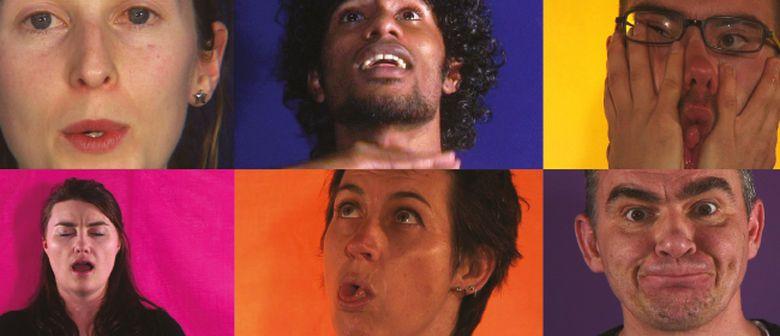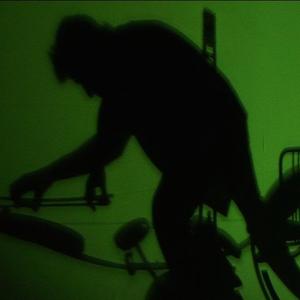In Melanesian pidgin, "toktok" is a term for conversation. In Phil Dadson’s video installation Bodytok Quintet (2006-ongoing), five large monitors arranged around the room individually spring to life when an audience member triggers the relevant motion sensors, thereby initiating a dialogue with some of the entertaining and somewhat ludicrous sounds that can be made with the human body.
Each screen features a portrait set against a brightly coloured background, and when activated presents a technique for making noise: from clicking tongues, snapping joints or squelching armpits, to particular slaps, whistles, taps and thumps. There is a mischievous departure from decorum, and the potential for them to be seen as puerile, but the commonality of these activities and straightforward presentation leads to captivating results. Sound gags are akin to party tricks, most likely perfected in childhood or moments of boredom, occasionally performed in social situations for friends or family, and now documented here as an archive, disrupting the respectable serenity of the public gallery setting.
Bodytok - the human instrument archive (2006) Phil Dadson
Unsurprisingly, these intensely personal actions produce intimate images. Not only are some created using erotic body parts, like the inner thigh or softly puckered lips, but shot in high-definition closeup, the freckles, pimples, and facial hair of the performers are all discernible, their faces growing pink from exertion as they perform. There is an element of rawness to the footage that matches the subject of the performances, both immediate and visceral. They also serve as a reminder of pre-lingual explorations of the body, that phase of sensual self-discovery, and youthful hours spent mastering a range of idiosyncratic skills. It seems the delight of these gestures is not diminished with time though, and these unusual dexterities and amusing competencies are infectious to watch.
The performers in Bodytok Quintet open the conversation by breaking the ice with their antics, prompting the desire for the audience to respond with their own "bodytok" in return. The interactive technology that is used to structure and facilitate the audience experience is slick, but the performances are made with no instrument other than the body, so although there is obviously a knack involved, it is quite possible that anyone could excel at such a craft, regardless of musical talent. I wonder if the opportunity to record or incorporate the spontaneous reactions of visitors would have added an interesting aspect to the work, providing a more dialogical experience, or perhaps that would make it too trivial? Whether captured or not, engaging with this collection of performances heightens the viewer’s awareness of their own body and no doubt recalls memories of rehearsing and enacting similar contortions in other circumstances. Like riding a bike, tricks like these are ingrained via motor memory, familiar and tangible, and I doubt many resisted a subsequent pop or whistle on their way out the door.
Showcasing roughly 50 participants in the installation, Bodytok Quintet is an archive of the body as instrument that Dadson began in 2006 and continues as an ongoing project. There is a diverse range of performers, rhythms and styles of noisemaking in the work, representing the breadth of society more generally. Culturally nuanced approaches to making sound are evident, for example, one appears to adapt a form of throat singing. At the same time there are many recognisable faces from the local artistic community, each contributing to the work through some connection to Dadson, so it is a reflection on sound and the body in this network. Considered as one of the fundamental aspects of life, it is a collection of community as well as skills and sounds.
Encountered individually, the participants offer a personal expression that is a one-to-one experience with the audience. When a few people are in the gallery space, multiple sounds are activated leading to a beautifully cacophonous orchestral arrangement, reinforcing the sense of collective, the quintet even resembling a family structure. Yet the simplicity of this project highlights the sincere pleasure of remembering that we exist as bodies in space, that patterns of behaviour are easily challenged, and that sometimes, small movements are significant.

